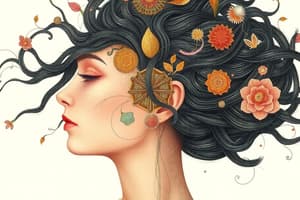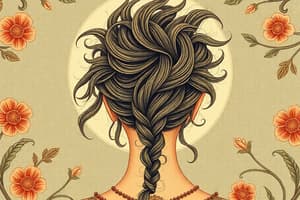Podcast
Questions and Answers
What is the telogen stage in the hair cycle?
What is the telogen stage in the hair cycle?
Shedding (resting) stage where hair rests and eventually sheds.
What is the average hair loss per day?
What is the average hair loss per day?
30-50 strands.
What is alopecia areata?
What is alopecia areata?
Patchy hair loss occurring on scalp and other parts of the body.
What is alopecia totalis?
What is alopecia totalis?
What is alopecia universalis?
What is alopecia universalis?
Which two methods are used for stretching the scalp?
Which two methods are used for stretching the scalp?
What is a scalp extender?
What is a scalp extender?
What is a scalp expander?
What is a scalp expander?
What causes dry scalp?
What causes dry scalp?
What is an oily scalp attributed to?
What is an oily scalp attributed to?
What is a whorl in terms of hair?
What is a whorl in terms of hair?
What is a cowlick?
What is a cowlick?
What is meant by hair stream?
What is meant by hair stream?
What is texture in relation to hair?
What is texture in relation to hair?
What does diameter refer to when talking about hair?
What does diameter refer to when talking about hair?
What are the three types of hair textures?
What are the three types of hair textures?
What is bacteria?
What is bacteria?
What is contamination?
What is contamination?
What is a disinfectant?
What is a disinfectant?
What occurs during an infection?
What occurs during an infection?
What does a Material Safety Data Sheet (MSDS) provide?
What does a Material Safety Data Sheet (MSDS) provide?
What does OSHA stand for?
What does OSHA stand for?
What is overexposure?
What is overexposure?
What is Personal Protective Equipment (PPE)?
What is Personal Protective Equipment (PPE)?
What are viruses?
What are viruses?
Two types of bacteria are __________.
Two types of bacteria are __________.
What is non-pathogenic bacteria?
What is non-pathogenic bacteria?
What is pathogenic bacteria?
What is pathogenic bacteria?
What are the three forms of pathogenic bacteria?
What are the three forms of pathogenic bacteria?
What are cocci?
What are cocci?
What are bacilli?
What are bacilli?
What are spirilla?
What are spirilla?
What does asymptomatic mean?
What does asymptomatic mean?
What are the two types of parasites?
What are the two types of parasites?
What are animal parasites?
What are animal parasites?
What do plant parasites produce?
What do plant parasites produce?
What are some other types of viruses mentioned?
What are some other types of viruses mentioned?
What is herpes simplex?
What is herpes simplex?
What does Human Hepatitis A, B, C do?
What does Human Hepatitis A, B, C do?
What is Human Immunodeficiency Virus (HIV)?
What is Human Immunodeficiency Virus (HIV)?
What is Acquired Immune Deficiency Syndrome (AIDS)?
What is Acquired Immune Deficiency Syndrome (AIDS)?
What are signs of infection?
What are signs of infection?
What is decontamination?
What is decontamination?
What are the three levels of chemical processes for controlling infection?
What are the three levels of chemical processes for controlling infection?
What is sanitation?
What is sanitation?
What is disinfection?
What is disinfection?
What is sterilization?
What is sterilization?
What is an autoclave container?
What is an autoclave container?
What is an ultraviolet container?
What is an ultraviolet container?
What is effleurage?
What is effleurage?
What is petrissage?
What is petrissage?
What is the direction of manipulation during a massage?
What is the direction of manipulation during a massage?
What is friction in massage?
What is friction in massage?
What is vibration in massage?
What is vibration in massage?
What is percussion or tapotement?
What is percussion or tapotement?
What are the components of a cell?
What are the components of a cell?
What is the cell membrane?
What is the cell membrane?
What is cytoplasm?
What is cytoplasm?
What is the centrosome?
What is the centrosome?
What is the nucleus?
What is the nucleus?
What is cell metabolism?
What is cell metabolism?
What is anabolism?
What is anabolism?
What is catabolism?
What is catabolism?
What are tissues?
What are tissues?
What is epithelial tissue?
What is epithelial tissue?
What is nerve tissue?
What is nerve tissue?
What is muscular tissue?
What is muscular tissue?
What is connective tissue?
What is connective tissue?
What is liquid tissue?
What is liquid tissue?
What is alopecia?
What is alopecia?
What is canities?
What is canities?
What is the cuticle?
What is the cuticle?
What is eumelanin?
What is eumelanin?
What is density regarding hair?
What is density regarding hair?
What is pheomelanin?
What is pheomelanin?
What is pityriasis?
What is pityriasis?
What is porosity in hair?
What is porosity in hair?
What is texture in relation to hair?
What is texture in relation to hair?
What is tinea?
What is tinea?
What is the cortex of the hair?
What is the cortex of the hair?
What is the medulla of the hair?
What is the medulla of the hair?
What does the hair root consist of?
What does the hair root consist of?
What is a follicle?
What is a follicle?
What is the bulb of the hair?
What is the bulb of the hair?
What is the dermal papilla?
What is the dermal papilla?
What is the arrector pili muscle?
What is the arrector pili muscle?
What do sebaceous glands do?
What do sebaceous glands do?
What does the development of a single strand of hair involve?
What does the development of a single strand of hair involve?
What are amino acids?
What are amino acids?
What is a protofibril?
What is a protofibril?
What is a microfibril?
What is a microfibril?
What is a macrofibril?
What is a macrofibril?
What is a cortical fiber?
What is a cortical fiber?
What are cuticle scales?
What are cuticle scales?
What is lanugo/vellus hair?
What is lanugo/vellus hair?
What is terminal hair?
What is terminal hair?
What are the three stages of hair growth?
What are the three stages of hair growth?
What is the anagen stage?
What is the anagen stage?
What is the catagen stage?
What is the catagen stage?
Flashcards are hidden until you start studying
Study Notes
Bacteria and Infection Control
- Bacteria are one-celled microorganisms thriving in dark, warm, and contaminated environments.
- Contamination is the presence of unclean materials on surfaces.
- Disinfectants are chemicals that destroy or inhibit the growth of microorganisms.
- Infections occur when pathogenic bacteria or viruses enter the body through openings or broken skin.
- Overexposure can cause allergic reactions or other unwanted side effects from excessive contact with substances.
Safety Regulations and Procedures
- Material Safety Data Sheet (MSDS) provides necessary information for handling and storing chemicals.
- OSHA sets and enforces employee training and education standards to improve workplace safety.
- Personal Protective Equipment (PPE) serves as a barrier against potential blood spills, including gloves and eye protection.
Types of Bacteria
- Two types of bacteria: Non-Pathogenic (helpful, making up 70% of bacteria) and Pathogenic (harmful, causing diseases).
- Pathogenic bacteria fall into three forms: Cocci (round), Bacilli (rod-shaped), and Spirilla (spiral).
Disease-Causing Agents
- Viruses are smaller than bacteria and invade human cells through cell walls.
- Examples of viruses include Herpes Simplex, Human Hepatitis (A, B, C), HIV, and AIDS.
- Animal parasites like Scabies and pediculosis cause diseases, while plant parasites cause infections like ringworm.
Infection Signs and Sterilization Methods
- Signs of infection include heat, ache, redness, pus, and swelling.
- Decontamination removes infectious materials from tools or surfaces.
- Three levels of controlling infection: Sanitation (removes dirt), Disinfection (destroys most bacteria), and Sterilization (destroys all microorganisms).
Massage Techniques
- Effleurage is a gentle gliding massage to relax muscles.
- Petrissage involves kneading movements that stimulate muscles.
- Friction is a deep rubbing movement enhancing circulation.
- Vibration involves rapid shaking for relaxation but is rarely used by cosmetologists.
Cell Structure Basics
- Cells consist of four main components: Cell Membrane (controls substance passage), Cytoplasm (contains nutrients), Centrosome (facilitates division), and Nucleus (contains DNA/RNA).
Tissue Types
- Four types of tissues: Epithelial (protective covering), Nerve (signal transmission), Muscular (movement), and Connective (support and protection).
Hair Structure and Growth
- Hair consists of the cuticle (protective outer layer), cortex (inner elastic layer), and medulla (deepest layer).
- Hair roots consist of the follicle, bulb, dermal papilla (nutrient supply), arrector pili muscle, and sebaceous glands (oil production).
Hair Growth Stages
- Three stages of hair growth: Anagen (growing stage), Catagen (intermediary stage where hair disconnects from the follicle), and Telogen (shedding/resting stage).
Hair Characteristics
- Average hair loss is 30-50 strands per day.
- Alopecia conditions include Alopecia Areata (patchy loss), Totalis (balding of the head), and Universalis (total body balding).
Scalp Stretching Techniques
- Scalp Extender is a stretchable sheet inserted during alopecia surgery.
- Scalp Expander is a balloon-like device gradually inflated to stretch the scalp prior to surgery.
Scalp Conditions
- Dry scalp occurs due to a lack of sebaceous gland activity, leading to flakiness and itchiness.### Oily Scalp
- Caused by overactive sebaceous glands, inadequate hygiene, poor diet, or unsuitable cleansing products.
- Characterized by a greasy appearance on the scalp and an oily coating on hair shafts.
Whorl
- A circular patch of hair that forms a distinctive pattern at or near the crown.
- More pronounced in children compared to adults.
Cowlick
- A tuft of hair that grows straight out from the scalp, differing in direction from surrounding hair.
Hair Stream
- Refers to hair follicles that are slanted and grow in the same direction.
- Opposite hair growth directions form natural parts or dividing lines in hair.
Texture
- Represents the tactile quality and measurement of each hair fiber's diameter.
Diameter
- The thickness or width of an individual hair strand.
Three Types of Hair Textures
- Hair can be classified into three textures: Coarse, Medium, and Fine.
Studying That Suits You
Use AI to generate personalized quizzes and flashcards to suit your learning preferences.




